If you have ever wondered how the sockets in your home are wired and receive power, they are connected together on something called a ring main, radial circuit or ring final.
To find out all about these circuits and how they are wired up, read on below.
Ring Mains, Wiring Regulations and Electrical Safety
As we all know, electricity is dangerous and potentially lethal if not handled with extreme care, so in order to work on and around it you must have the necessary knowledge and skills to be able to adhere to BS 7671 Wiring Regulations, be able to fully test any work and also issue a certificate after any works have been completed. With this in mind, the only person able to do this is a Part P registered electrician.
Part P of the new building regulations could involve a check on any additional circuitry by qualified electricians when you sell your home. If you don’t have a certificate to prove any works have been carried out correctly then this can affect selling your home as, you are effectively breaking the law and also your house insurance may not be valid.
Essentially, if you understand this paragraph then you are able to test yourself. If you do not, leave it alone.
Put two block connectors on the two cables feeding a socket and tested both blocks with both earth loop and PSC to ensure it is part of a ring main before adding a spur.
Aside form the Part P requirements, there are quite a few other rules that govern how a ring main is installed such as the type of cable that can be used, the total floor area the circuit covers, the total length of the circuit and whether it’ll be powering outdoor appliances, more on this below.
Some other points to be aware of in terms of ring mains and wiring is that you may find that you have several different types of wire colours used in your home. A few years back the UK wire colours were changed so that they harmonised with those used in Europe. To find out more about this see our new wiring and cable colours project here.
There are also rules on how high sockets can be placed on walls and other surfaces when they are installed from scratch. For regulations governing this, please our socket height regulations project page here.
Finally, for more help and information on staying safe when working around electricity, see our electrical safety project here.
What is a Ring Main or Ring Final Circuit or Final Circuit?
A ring main, or ring final circuit, is exactly what it says on the tin. It’s a ring of cables, usually a live, neutral and earth 2.5mm twin and earth that circles your home, carrying mains electricity to all of your sockets. It gets the power from the consumer unit, delivers it to each socket and then runs back to the consumer unit again.
The main advantage of a ring main is that if a breakage occurs in the circuit anywhere everything will still continue to work correctly as the power can also be fed from the other end of the circuit backwards as electrical power can flow both ways.
In most homes today you will generally have 2 socket ring circuits, one for upstairs and one for downstairs. This will generally then be split in your consumer unit, with each circuit being protected by a separate RCD so that if one circuit goes down, the other will still have power. See our consumer unit project here for more information.
When it comes to the name, ring main is a term which has been used for years and in all likelihood will continue to be used for many more to come, but it is in fact incorrect, it’s just easy to say!
The correct terminology for a ring main is either Final Ring Circuit or Ring Circuit, however, now you know that we will continue to refer to it in the most common parlance as seen all over the internet and on building sites across the land.
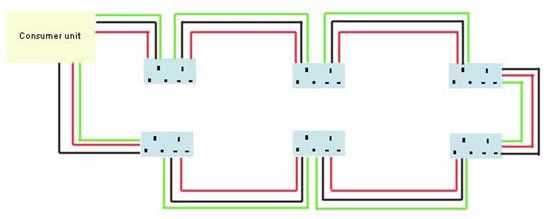
A standard ring main, final main, ring circuit or final circuit ring
How Does a Final Ring Circuit or Ring Main Work?
When it comes to how a ring main works, it’s fairly straight forward in that in the consumer unit it will have it’s own MCB or RCBO (find out more in our fuses project here), with the live wire connected to the live terminal on the MCB/RCBO, the neutral connected to the neutral bar and the earth connected to the earth bar, it then circles the property back to the consumer unit where the other end of the cable is connected to the same terminals once more, creating a complete loop.
As both ends of the ring are connected to the same terminals at the consumer unit, the current runs in both directions imposing less of a load on the cables. Electricity loses power over long lengths of cable and trying to put too much power through a cable which is not designed for it is dangerous, so a ring main delivers power from both ends to keep the load as light as possible.
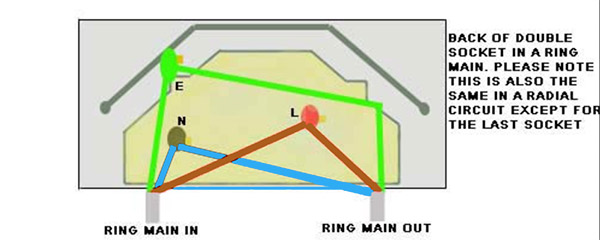
Wiring a socket correctly in a final ring circuit or ring main
The other common type of circuit used to power your home is a radial circuit. They are not so common in the UK but are used extensively abroad as the ring main, or final ring circuit does have it’s drawbacks.
The radial circuit can be turned into a ring circuit by completing the wiring back to the consumer unit and similarly the ring main, or final circuit ring can be turned into two radial mains by removing a section of the ring. This is one of the failure points of a ring main or final ring circuit
If you would like to find out more about these circuits, see our project on radial circuits.
How Can I Tell if my House has Radial Circuits or Ring Mains (Final circuits)?
Identifying a radial circuit and a final ring circuit requires a test. A sparky (electrician) will disconnect the wires in the consumer unit and test continuity between the two cables on the live and return terminals.
Sockets on a ring main have at least two sets of wires connected to them, but spurs may also have two sets of wires and so do sockets on a radial circuit, all except the last one anyway so counting cables on the back of sockets is not a safe way to identify a ring circuit or ring main.
Ring circuits are normally fed with a 30 or 32 amp fuse or MCB, but if feed is supplied through a 4mm cable then the spurs could also be feed with 30 or 32 amp fuse or MCB.
If the circuit was originally a ring main but this has become broken and is now a spur or radial main then it could be fed with 2.5mm and 32 amp fuse.

Use a multi-meter to test for a radial or ring main (final ring circuit)
Even though the sockets are connected to two cables or 2.5mm and supplied by a 32 amp fuse or MCB it cannot be guaranteed that it is a ring main or final circuit.
In short if you cannot correctly test whether the circuit you have is a ring main or a radial circuit then you should not, under any circumstances be working on it. The UK is the only country in the world to work with ring mains, or final ring circuits and without the correct testing equipment and knowledge of procedures it is impossible to tell the difference.
We would like to thank one of our forum members for answering this question in our busy electrical forum, more information can be found on testing circuits here.
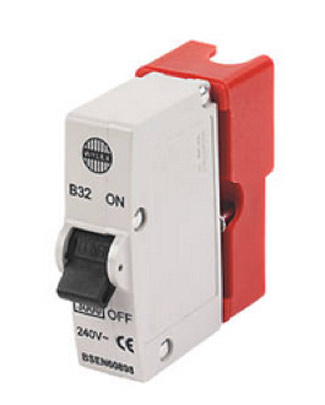
Ring circuits usually protected by a 32 amp MCB
Restrictions on a Ring Main or Ring Circuit
As we have mentioned, one of the issues with using a ring main is that there are numerous restrictions and requirements you need to be aware of when it comes to how it’s wired up, the most common are as follows:
- Total length of circuit
- Total floor area of circuit
- Type of cable
- Powering outdoor appliances
There are restrictions on how much power and for how long, a ring main or final ring circuit may carry. This is reflected in the maximum distance a cable may be used for and the fuse rating it is given. Please see cable length restrictions below for more information.
To help manage this, in most consumer units, a separate ring main is usually installed on every floor of a given property to make sure things are kept safe and manageable in that if an issue occurs on one circuit, this won’t be reflected in the other circuits and they should still work as intended.
Many issues often occur when a spur socket (additional socket) is added on an upstairs ring main, to feed a socket or light on a downstairs circuit, so this is why the Part P regulation exist to prevent such issues.
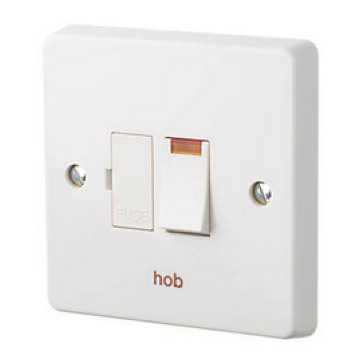
Switched fused spurs can be used for cookers, showers, dishwashers and washing machines
The other common circuit in your home, the lighting circuit is generally fed from a radial circuit. This type of circuit, as the name suggests, radiates out from your consumer unit, however it doesn’t run back, it ends with the last light or socket.
However it is possible for both a ring or radial circuit to power lighting, but it requires the use of a fused spur which is fused independently of the circuit the power is coming from. You can see more about how a switched or fixed fused spur works in our project here.
A switched fused spur is also used when connecting a cooker hob, dishwasher, washing machine or fridge to the circuit. It allows the appliance to be switched on and off from a position above the worktop, or at least a more easily reachable position than the socket they are plugged into (which is normally located below worktops and behind the appliance). The switched fused spur interrupts the socket and allows it to be switched on and off.
However, coming back to our radial circuit, the main restrictions to be aware of are as follows:
Cable Used for a Ring Main or Final Ring Circuit
A ring main uses 2.5mm twin and earth cable comprising of a live, neutral and earth (T&E or two core and earth cable as it’s also known). The 2.5mm is the measurement of the cross sectional area of the cables.
The reason this size cable is used is that it ensures that enough current can be supplied to all the likely appliances that could be plugged into it and also that any voltage drop won’t be sufficient enough to effect the operation of appliances.
This is obviously just for standard plug in appliances e.g. dishwashers, washing machines, TV’s and the likes. For more substantial power hungry appliances such as cookers and showers, it will depend on how much power they draw as to what size cable is used.
An example of some 2.5mm twin and earth cable type can be seen below and shows the live, neutral and earth wires.
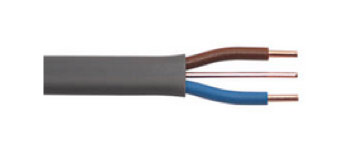
2.5mm twin and earth electrical cable with neutral wire, live wire and bare earth wire
Note: As the earth wires are bare, once connected up it then needs some earth sheath slipping over it to signify that it’s the earth.
Floor Area for a Ring Main or Final Ring Circuit
The floor area a ring main serves is also governed. This is because the regulation people have some idea of how much power and lighting we can expect to use in such an area and so due to this the maximum area for a ring main is 100 square meters.
This ensures that any voltage drop is limited and ultimately acceptable for pretty much any home and also that there is enough voltage to power any likely appliances with overheating and the potential of fire.
As an average house has a footprint of about 64-70 square meters so, this also allows for the continuation of the ring into a porch or garage. The ring main must be protected by a 30amp fuse if it is on a cartridge/re-wirable fuse board or a 32amp MCB fuse.
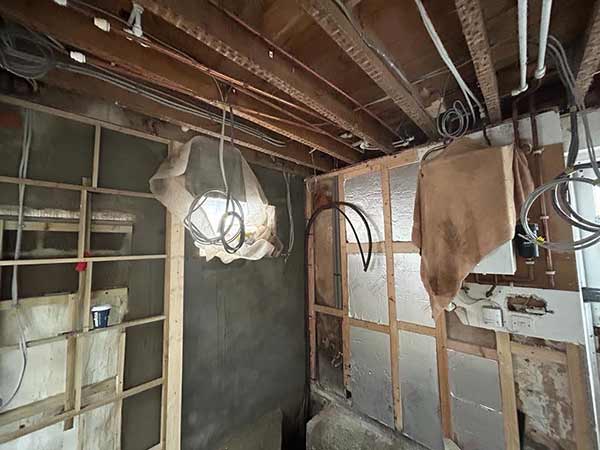
Socket ring main being run around extension
Length of Cable Limitations in Ring and Radial circuits
When it comes to the actual maximum length of cable you can use for a ring main, the cable itself should be up to 60 meters long if it is protected by a cartridge fuse and 50 meters long if protected by an MCB and also should not exceed the maximum 100 square metre floor area.
These rules apply for both ring mains and radial circuits and you also have to be aware that adding spurs to an existing circuit will also count towards the total length. Adding long spurs could make you exceed the limit!
These rules exist for very good reasons as if it’s too long you are asking the circuit to use much more energy than it is designed for. More energy = more heat and when this happens, cables can very easily catch fire!
Outdoor Appliances
The final main restriction in terms of how a ring main is wired is if it’s likely to be powering any lighting or appliances outdoors. If this is the case the regulations state that any socket which is capable of being used to supply power outside of the house must be protected by an RCD (residual current device).
As we have mentioned above, today this is taken care of by the fact that each circuit in your consumer unit is protected by at least 1 RCD.
Is There a Limit to Number of Sockets on a Ring Main?
As stated in the BS7671 Wiring Regulations, there is no limit to the number of sockets you can have on a ring main but there is a limit to the number of spurs you can have from those sockets or from the wiring between them. This is limited to 1 socket per existing socket or junction box.
However it is possible to add more but they should always have a fused connection unit or FCU between them and the location you’re taking power from.
If you would like to know how to add a spur to an existing ring main, see our project on adding a spur socket here.
It is possible to extend a ring main if you need to. For help and information on how to do this, please see our extending a ring main project here.
Cooker and Electric Shower Circuits
Units or appliances which use a lot of power, like cookers and showers, must be installed on their own circuits, this is the law as stated in BS7671 Wiring Regulations.
As appliances such as this use so much power, their own dedicated circuit will ensure that they always have enough without creating too much draw which then in turn creates a lot of heat and the potential for fire!
As these types of circuit run out to the given appliance but don’t return back to the consumer unit, they are in effect a radial circuit and not a ring main.
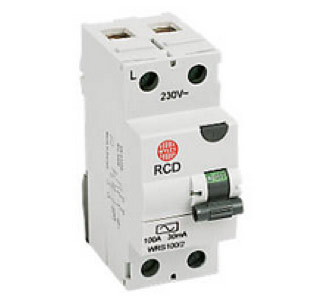
RCD protection is the norm in modern consumer units
How to Wire a Ring Circuit or Ring Final
By now you should be totally familiar with exactly what a ring main or ring final circuit is and how it works. As a radial circuit should only ever be installed by a Part P registered electrician, you won’t be wiring one up yourself.
However to be sure that your electrician is doing it correctly, this is generally the process that’s followed:
- Step 1 – Isolate Power: Before any work actually takes place, the very fist job is to isolate the power to the whole consumer unit so it can be worked on safely
- Step 2 – Install MCB/RCBO: As the circuit must have its own MCB or RCBO, first a new one is installed within the consumer unit in the appropriate place. Depending on what it will be powering will depend where it goes as the more power hungry circuits tend to be placed closer to the main switch and RCD
- Step 3 – Run Cable: Once the consumer unit is sorted the next job is to run the cable from the consumer unit out to every socket location and then back to the consumer unit again. Depending on where this is being run will depend on how easy it is
- Step 4 – Connect Up Sockets: Once the cable is run, generally the next job is to connect up each and every socket on the circuit correctly
- Step 5 – Connect to MCB/RCBO: Once all the sockets are wired up correctly the next task is to then connect up the ring main to its MCB/RCBO. Generally this is done by connecting both live wires at each end to the live terminal of the MCB/RCBO, both neutrals to the same terminal on the neutral bar and both earths to the same terminal on the earth bar
- Step 6 – Test: Once all connected up the power is turned back on and the electrician will then carry out a full test on the circuit to ensure all is well. Finally he then completes and issues a minor works certificate to state all has been done to the required regulations level
Other Electrical Resources
Other helpful electrical projects that may be useful if you are looking into information on ring mains are as follows:
- Adding extra sockets
- Blowing light bulbs
- Consumer units
- connecting an electric shower
- dimmer switches
- earth bonding in bathrooms
- electrical safety
- Extending a ring main
- flexes wires and cables
- fuses
- garden and outdoor lighting
- lighting circuit
- lights and switches
- Part P Building regulations
- radial circuit
- replacing a light fitting
- Stripping wires and cables
- wiring a junction box
- wiring in wall lights
Wiring up a ring main is notifiable works and should only ever be done by someone with the necessary skills and knowledge to do it safely, test it fully and then issue a certificate, namely a Part P registered electrician. If you are looking to install a ring main then do it correctly and get the pros in to do it!

